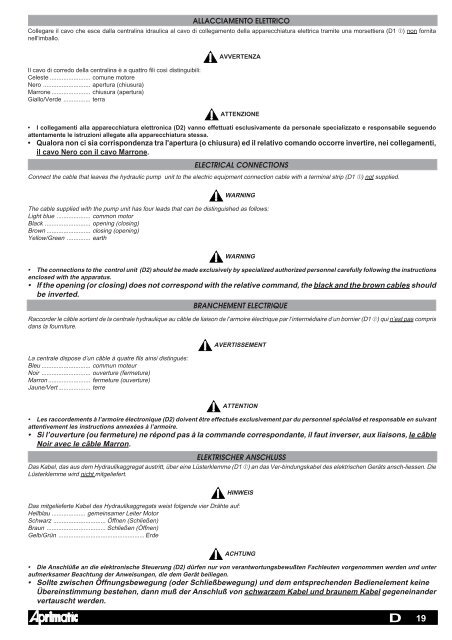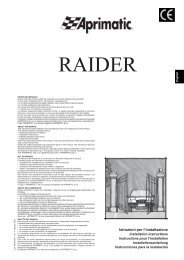ZT 71 ZT 72 - Cyclon Engineering
ZT 71 ZT 72 - Cyclon Engineering
ZT 71 ZT 72 - Cyclon Engineering
Create successful ePaper yourself
Turn your PDF publications into a flip-book with our unique Google optimized e-Paper software.
ALLACCIAMENTO ELETTRICO<br />
Collegare il cavo che esce dalla centralina idraulica al cavo di collegamento della apparecchiatura elettrica tramite una morsettiera (D1 ➀) non fornita<br />
nell'imballo.<br />
Il cavo di corredo della centralina è a quattro fili così distinguibili:<br />
Celeste ........................ comune motore<br />
Nero ............................ apertura (chiusura)<br />
Marrone ....................... chiusura (apertura)<br />
Giallo/Verde ................ terra<br />
AVVERTENZA<br />
ATTENZIONE<br />
• I collegamenti alla apparecchiatura elettronica (D2) vanno effettuati esclusivamente da personale specializzato e responsabile seguendo<br />
attentamente le istruzioni allegate alla apparecchiatura stessa.<br />
• Qualora non ci sia corrispondenza tra l'apertura (o chiusura) ed il relativo comando occorre invertire, nei collegamenti,<br />
il cavo Nero con il cavo Marrone.<br />
Connect the cable that leaves the hydraulic pump unit to the electric equipment connection cable with a terminal strip (D1 ➀) not supplied.<br />
WARNING<br />
The cable supplied with the pump unit has four leads that can be distinguished as follows:<br />
Light blue .................... common motor<br />
Black ........................... opening (closing)<br />
Brown .......................... closing (opening)<br />
Yellow/Green .............. earth<br />
WARNING<br />
• The connections to the control unit (D2) should be made exclusively by specialized authorized personnel carefully following the instructions<br />
enclosed with the apparatus.<br />
• If the opening (or closing) does not correspond with the relative command, the black and the brown cables should<br />
be inverted.<br />
BRANCHEMENT ELECTRIQUE<br />
Raccorder le câble sortant de la centrale hydraulique au câble de liaison de l’armoire électrique par l’intermédiaire d’un bornier (D1 ➀) qui n’est pas compris<br />
dans la fourniture.<br />
La centrale dispose d’un câble à quatre fils ainsi distingués:<br />
Bleu ............................. commun moteur<br />
Noir ............................. ouverture (fermeture)<br />
Marron ......................... fermeture (ouverture)<br />
Jaune/Vert ................... terre<br />
AVERTISSEMENT<br />
ATTENTION<br />
• Les raccordements à l’armoire électronique (D2) doivent être effectués exclusivement par du personnel spécialisé et responsable en suivant<br />
attentivement les instructions annexées à l’armoire.<br />
• Si l’ouverture (ou fermeture) ne répond pas à la commande correspondante, il faut inverser, aux liaisons, le câble<br />
Noir avec le câble Marron.<br />
ELEKTRISCHER ANSCHLUSS<br />
Das Kabel, das aus dem Hydraulikaggregat austritt, über eine Lüsterklemme (D1 ➀) an das Ver-bindungskabel des elektrischen Geräts ansch-liessen. Die<br />
Lüsterklemme wird nicht mitgeliefert.<br />
HINWEIS<br />
Das mitgelieferte Kabel des Hydraulikaggregats weist folgende vier Drähte auf:<br />
Hellblau .................... gemeinsamer Leiter Motor<br />
Schwarz ............................... Öffnen (Schließen)<br />
Braun ................................... Schließen (Öffnen)<br />
Gelb/Grün ................................................... Erde<br />
ELECTRICAL CONNECTIONS<br />
ACHTUNG<br />
• Die Anschlüße an die elektronische Steuerung (D2) dürfen nur von verantwortungsbewußten Fachleuten vorgenommen werden und unter<br />
aufmerksamer Beachtung der Anweisungen, die dem Gerät beiliegen.<br />
• Sollte zwischen Öffnungsbewegung (oder Schließbewegung) und dem entsprechenden Bedienelement keine<br />
Übereinstimmung bestehen, dann muß der Anschluß von schwarzem Kabel und braunem Kabel gegeneinander<br />
vertauscht werden.<br />
D<br />
19



